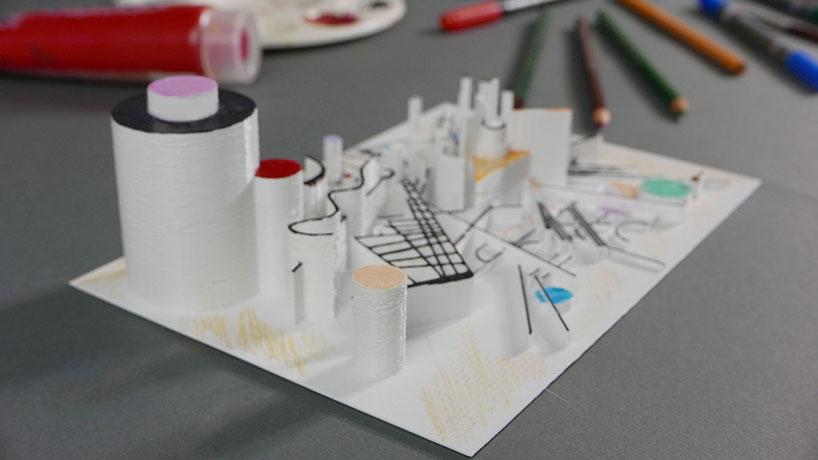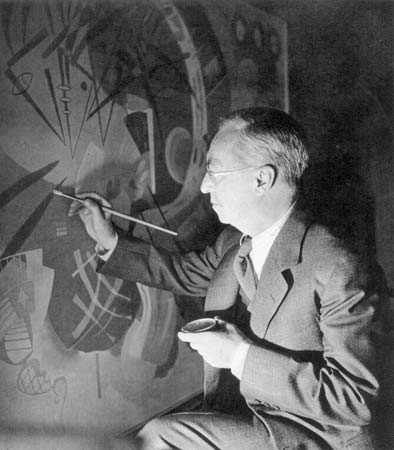At the age of 30, Moscow native Wassily Kandinsky had a comfortable career teaching law and economics, and he gave it all up to enroll in art school in Munich.
But things didn’t go exactly to plan. Kandinsky failed on his first attempt to gain admission to school, so he began his study of art on his own time. The year before he left Moscow, the budding artist saw an exhibit of paintings by Monet, and he was stunned by the power of the impressionistic style of the series “Haystacks,” as he noted:
“I dully felt that the object of the painting was missing. And I noticed — with surprise and confusion — that the picture not only gripped me, but impressed itself ineradicably on my memory. Painting took on a fairy-tale power and splendor.”
When Kandinsky returned to Moscow following the outbreak of World War I, his early impressionist style hardened into a more avant-garde, geometric pictorial vocabulary. The paintings — once filled with compositional elements taken from nature and resembling clouds, the sun, mountains, and references to the landscape painting tradition — devolved to geometric and basic biomemetic keys which heralded a new vision of what art could become.

Composition VIII
Works like Kandinsky’s “Composition” series became lynchpins of abstract painting and inspired generations of painters to follow suit in their search for new forms of expression.
“The circle is the synthesis of the greatest oppositions,” Kandinsky said of the metamorphosis of his style. “It combines the concentric and the eccentric in a single form and in equilibrium. Of the three primary forms, it points most clearly to the fourth dimension.”
And now three former Autodesk employees who worked on AutoCAD for mobile have looked to the past to create new software which brings 3D printing to bear on the future of design and artistic expression.
“We chose ‘Composition VIII’… since the original idea behind this series of compositions was to experiment with the medium of painting,” says Eviathar Meyer, the co-founder and CEO of UMake. “Our take was to do the same sort of experimentation, but interpreting it within the medium of 3D design and printing. We wanted to showcase a piece that uses geometric shapes to be seen as an architectural plan from one angle, and as modern artwork from another.”
 Meyer says the process of making the piece wasdivided among different tools and methods. The team started by sketching the geometric shapes and lines using their app, UMake.
Meyer says the process of making the piece wasdivided among different tools and methods. The team started by sketching the geometric shapes and lines using their app, UMake.
“It’s just easier to trace over and sketch these shapes on a tablet and stylus, rather than tracing it over with a mouse on desktop software. After we finished the sketch in 2D, we started to create surfaces from the geometry,” Meyer says. “It was fun playing with that and imagining how a city could be created from a 2D piece of art.”
Once the original sketches were complete, the result was exported to the IGES file format and refined with Rhino 5. The 3D design for printing was fleshed out by filling any gaps and sharpening details, and then the files were taken to TechFactoryPlus for output on a Witbox 3D printer.
“We debated whether to use PLA or wood materials, because I really loved the wood texture, but eventually we decided to go with white PLA so it would better represent a blank white canvas,” Meyer said. “It took us around six hours to print this model, and the quality of the Witbox was pretty incredible – it worked perfectly on the first try.”
Meyer says his nascent company is launching a private-beta this week, and he adds that the software will support iPad 3rd generation or iPad Mini 2 and up when running iOS 8. He says the purpose of the beta program is to test the user experience for UMake to see how improvements can be made to enable more people to make 3D designs easily and intuitively on their tablets.
Would you be interested in 3D software like UMake for your tablet? Let us know if you plan to sign up for the UMake beta process in the Painting Meets 3D Design and Printing forum thread on 3DPB.com. Check out the video below of the production process for turning the 2D painting into a 3D sculpture.
Subscribe to Our Email Newsletter
Stay up-to-date on all the latest news from the 3D printing industry and receive information and offers from third party vendors.
You May Also Like
Profiling a Construction 3D Printing Pioneer: US Army Corps of Engineers’ Megan Kreiger
The world of construction 3D printing is still so new that the true experts can probably be counted on two hands. Among them is Megan Kreiger, Portfolio Manager of Additive...
US Army Corps of Engineers Taps Lincoln Electric & Eaton for Largest 3D Printed US Civil Works Part
The Soo Locks sit on the US-Canadian border, enabling maritime travel between Lake Superior and Lake Huron, from which ships can reach the rest of the Great Lakes. Crafts carrying...
Construction 3D Printing CEO Reflects on Being Female in Construction
Natalie Wadley, CEO of ChangeMaker3D, could hear the words of her daughter sitting next to her resounding in her head. “Mum, MUM, you’ve won!” Wadley had just won the prestigious...
1Print to Commercialize 3D Printed Coastal Resilience Solutions
1Print, a company that specializes in deploying additive construction (AC) for infrastructure projects, has entered an agreement with the University of Miami (UM) to accelerate commercialization of the SEAHIVE shoreline...






























